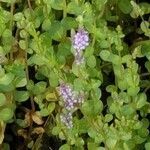Perennial or annual herb. Stems usually branched, erect, floating or creeping, to 30 cm long. Leaves decussate, sessile or shortly petiolate, broadly elliptic to orbicular, to 1.2 cm long. Bracts ovate, obtuse, sometimes apiculate, the base obtuse; inflorescence bract to 4 mm long; flower bract to 2 mm long; bracteoles lanceolate, usually less than or equal to hypanthium length. Flowers subsessile, in distinct many-flowered racemes. Hypanthium campanulate, to 1 mm long; appendages absent. Sepals 4, triangular, to 1 mm long. Petals 4, obovate, 2–3 times as long as sepals, mauve. Stamens 4, inserted near base of hypanthium. Style to 0.5 mm long. Capsule globose, c. 1.5 mm diam., opening by 4 valves.
A herb. It lies along the ground. It is about 25 cm high. The leaves do not have leaf stalks. The leaves are in four rows along the stem with opposite pairs at right angles. They are 3-11 cm long by 2.5-10 cm wide. They are round or broadly oval. The flowers are pink. They occur in dense spikes at the ends of branches. The fruit is a capsule. It is oval.


